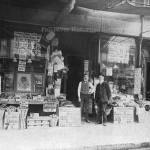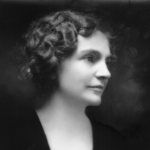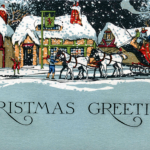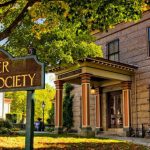The FRHS archival collections contain thousands of bound volumes and several hundred thousand manuscripts, either individual examples or fonds, all pertaining to various aspects of Fall River history; they date from the 18th through to the mid-20th century. Fonds, by the way, defines a group of documents of the same origin pertaining to the same subject – a collection of business records, or school enrollment cards, for example.
Significantly, the FRHS archival collections are ever-growing and one never knows when, or where, additional items – or collections of them – will turn up, oftentimes from the most unlikely sources; it never ceases to amaze me.
To name just a few categories of material housed at the FRHS: Business, of which there are ledgers, account books, and manuscripts; Civic, with records of nearly every department; Church, documenting many faiths; and Clubs and Societies– organized and private, and of every description.
Each of these records contains lists of names – oftentimes very extensive – handwritten in elaborate flowing script, that in many cases may well be the only extant evidence of that individual’s life in Fall River, the only record of the part they once played in day-to-day life of the city.
But as mere names on paper they are of very little use – the vast majority of these records were not indexed when originally compiled, and sorting through them in search of a particular person is a by-chance, catch-as-catch-can affair, a veritable needle in the haystack situation.
Did I mention that it is time consuming? In fact, it borders on excruciating.
But it can be done: Recently the BBC visited the FRHS to film an upcoming episode of the popular genealogy-based television series Who Do You Think You Are? A local researcher spent days combing through Troy Mills account books dating to the 1870s looking for any record of a particular family – the ancestors of rather a famous Brit – who had immigrated to Fall River seeking a better life.
The researcher found the information – quite a bit of it, actually – prompting the BBC’s visit to Fall River a few weeks ago, but it was a fortuitous chance occurrence, and lady luck undoubtedly played her part. Experience has shown me that it most often does not work out that way.
We cannot yet reveal the identity of the “famous Brit” – confidentiality, you know.
So, the information contained in these myriad records – important as historical documents – is, in fact, of little use until it can be made fully accessible. It must be catalogued, with the individual names entered into a searchable biographical database. Once that is done, the information is immediately transformed into a far more valuable historical record, of ready use to researchers, scholars, and genealogists.
And so, for decades, material was collected by the FRHS and archived, awaiting the day when the tools were in place to begin the extensive process of cataloguing.
Fortunately, the time has finally come: This work is underway.
The museum software system currently used by the FRHS for collections management contains a People Biography field that allows for linking individual biographical records and contextual information for specific items – artifacts, archival materials, photographs, publications, and the like.
For example: If cataloguing a Durfee Mills rent receipt book, the names of each tenant listed in the document would be entered in a “People” field built into the object record, thus creating an associated People Biography record. The linked People Biography record contains preset fields that allow the cataloguer to record pertinent biographical information, add digitized photographs, and/or create customized fields when necessary.
Fabulous! A Godsend, really.
A hypothetical scenario:
William H. O’Malley worked as a weaver in the Durfee Mills and rented an apartment from the company in 1868; when cataloguing that particular volume, his name was entered into the “People” field in the object record, automatically creating an associated People Biography record, where pertinent information gleaned from the volume was recorded.
Fast-forward: 2019.
O’Malley’s great-great-granddaughter visits the FRHS doing genealogical research.
Her question:
“Does the FRHS have any material pertaining to William H. O’Malley? He lived in Fall River briefly in the 1860s and I cannot find him listed in the city directory.”
Enter the name into the People Biography search bar and … there you have it.
The answer:
“Yes, we do.”
If not for the collections management software – and the time spent entering the associated names – the answer would have been: “No, there is nothing accessible in the collection.”
Clearly, this is an extremely valuable tool, opening up a wealth of possibilities for the FRHS in archival collections management, thus allowing the museum to fulfill a fundamental role in making heretofore obscure records accessible to patrons.
Great stuff, that.
Over the past two months, the following collections have been fully catalogued, and associated People Biography records have been created:
- Durfee Mills employee insurance cards, 1919-1925, with biographical information pertaining to 649 individuals. These cards were recently found in a Fall River garage and donated to the FRHS – the donor had no idea why she had them.
- Troy Mills payroll receipts, 1870s, with information pertaining to 2687 individuals – many were women and young children whose names do not readily appear elsewhere. These were donated by a collector of Fall River memorabilia.
- Report Cards from various Fall River public schools, early- to mid-20th century, recording significant biographical information on 2682 individuals. These were rescued from a dumpster by a contractor who, fortunately, realized “they were old and should be in the historical society.”
Total number of individuals recorded to date: 6018
The collection currently in the process of cataloguing – a second, vast file of Report Cards from various Fall River public schools, early- to mid-20th century – contains, in conservative approximation, an additional 48,000 individuals.
Incidentally, these records were also rescued from the trash.
But this is just the beginning, and represents only a microscopic fraction of the millions of individuals that are in some manner represented in the FRHS holdings. A room full of clerical workers – if such a thing existed at the FRHS – would have many years of work ahead of them.
Claudette Aubin, the FRHS staff member engaged in this task, is chipping away at the mass of material, one name at a time. When told that the collection she is presently working on contains approximately 48,000 names, she uttered two words: “Dear God!”
The task is a daunting one – very much so.
But it is equally rewarding.
How much so?
Ask O’Malley’s great-great-granddaughter.












